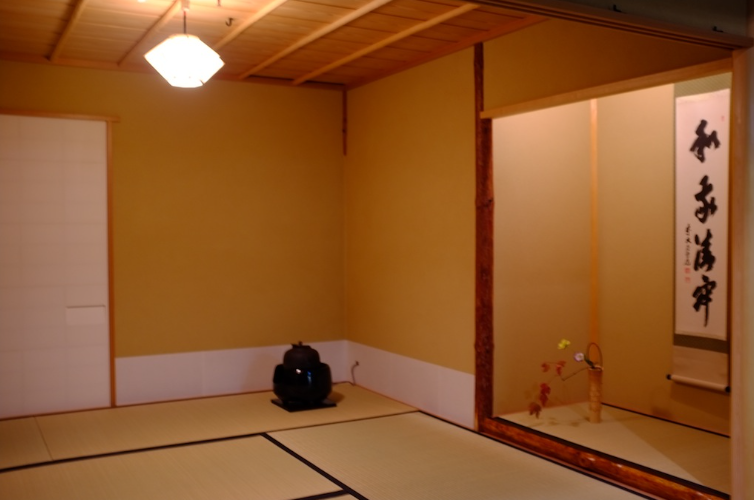
The Traditional Japanese Tea Ceremony Room in the University of Warsaw Library Building
History
In June of 2004 the Warsaw University Library and the Japanese Studies Section, Institute of Oriental Studies, received a most precious gift, a Japanese tea ceremony pavilion, or chashitsu, as an example of traditional Japanese architecture and the Japanese art of garden designing. The chashitsu was generously donated by the Kyōei Steel Company from Osaka, represented by President Akihiko Takashima and COO Hideichirō Takashima, and Mrs. Kazuko Takashima, Honorary Consul General of the Republic of Poland in Osaka. The pavilion is used by students of the Japanese Studies Section, as well as other faculties, and also by other persons who are interested in Japanese traditional culture. The Japanese Studies Section plans to use the chashitsu to conduct classes in Japanese culture and aesthetics, for the tea ceremony demonstrations that will be open to students of Warsaw University and for other cultural activities. The pavilion is the only one of its type in Poland, and, after England, the second in Europe.
The pavilion in the Library consists of two rooms for tea gatherings (called chakai) and the room called mizuya, or the water house, being a preparation room where the tea utensils are washed and stored. Floors of all the rooms are covered with tatami mats, made from tightly woven grass and straw. In both of the rooms — the bigger (hiroma) and the smaller one (koma), there are tokonoma, or small alcove spaces, where precious ornaments, like calligraphy, or flowers are presented. Guests enter the smaller room through nijiriguchi, a so-called crawl-through door, which is very narrow (only about 66 by 60 cm) and thus makes all the persons who enter bow modestly. The host and his assistants enter through a fusuma door, which is an opaque sliding screen. In front of the pavilion there is a roji, or open path, a tea garden through which guests must pass to reach the rooms. All of the construction materials, like Japanese cedar and pine wood, bamboo, Japanese handmade paper, and even the stones and gravel used for the pavilion and the garden, are in accord with traditional architecture rules and were brought entirely from Japan.
A word from the benefactor
Kazuko Takashima
“In 1993 my brother, Kōichi Takashima, the president of Kyōei Steel Co., came to Poland for the first time and paid a visit to Warsaw University. As a direct result the Takashima Foundation was founded and ever since then has been actively engaged in the activities of the Japanese Studies Section there. The main objective of the Foundation is popularizing Japanese culture and supporting the progress of Japanese studies in Warsaw. In 1997, during his next visit, Kōichi Takashima gave Warsaw University plants of the sakura (cherry) tree, which is a symbol of Japanese culture. He intended to carry out many other projects, but unfortunately his plans were thwarted by his premature death. His wish to propagate Japanese culture in Poland was carried on by his successors: his brother Akihiko Takashima, his son Hideichirō Takashima and myself. Akihiko Takashima is, among others, a member of the Japanese-Polish Society (active in Osaka), which supports scholarship students from Poland.
In August of 2004, a Japanese tea ceremony pavilion was built in the Warsaw University Library, as a further expression of cultural friendship between our countries. I am exceedingly pleased that I have been able to contribute to making come true not only the dreams of my brother and my family, but also of all the members of the Japanese-Polish Society from Osaka. I hope the pavilion will make the students of the Japanese Studies Section, and all other persons interested in Japan, feel closer to traditional Japanese culture, and that it will make it more popular not only at Warsaw University, but in broader society circles”.
Ex-Consul-General of
Republic of Poland in Osaka
Builders of the tea ceremony pavilion
Dr. Teruhito Iijima — author of the pavilion design.
Born in 1958, he graduated from Urasenke Gakuen Professional College of Chado and completed the Ph.D. program at the Takarazuka University of Art and Design. In 2002 he published Cha no takumi (Masters Craftsmen of Tea) and has also authored many popular and academic articles on Japanese achitecture and culture.
Oda Kōji — chief carpenter
Aoki Eizō — master plasterer
Tanaka Raizō — carpenter
Nisoichi Kikuo — carpenter
Ueda Toshio — carpenter
Ogawa Masayuki — master gardener
Minato Shingorō — gardener
